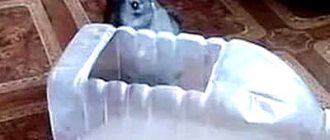- home
- Care
15.04.2018
Hamsters are very clean animals. They take care of their home, throwing garbage outside, and wash themselves often. To help the animal live clean, you can organize a special dry bath for it. Sand is very important for a hamster: in it the animal can clean its paws and fur from excess debris and fat.
Is it possible to bathe a dwarf hamster in water?
Water procedures are a great stress for the animal and the risk of complications. But in some situations it is justified:
- Contamination of wool with hazardous food products. For example, the animal has become dirty with mayonnaise, jam, butter or other fatty and sticky substances. If you do not bathe in time, your pet will eat too much, which will lead to indigestion or poisoning.
- Contact with wool of household chemicals. For example, floor or dishwashing detergents, acetone, etc.
- The appearance of parasites: lice, ticks, lice eaters. In such a situation, bathing the hamster with a special medicated shampoo will quickly and effectively get rid of parasites.
If the animal shows signs of infection, it is recommended to show it to a veterinarian as soon as possible, who will conduct an examination and prescribe the optimal treatment. It is not recommended to select medications for parasites on your own, as this can worsen the health of the rodent.
Article on the topic: Hibernation in red-eared turtles at home: signs, causes, care (photo)
Requirements for the toys used
Toys for chinchillas must meet certain requirements. The most important condition is the material of manufacture. Do not use toys made of rubber, cement, lime, glass and plastic of dubious quality. Prohibited raw materials include some types of wood. These include cherry, oak and conifers. They are rich in resin, which is harmful to the rodent's body. Because of it, the gastrointestinal tract is disrupted. If complications occur, there may be poisoning.
Other contraindications include the following:
- Toys should not have sharp corners or jagged edges. The animal could be seriously injured. In homemade toys, you can get rid of them using sandpaper.
- Small objects in products can cause suffocation for your pet. He can take a bite and swallow a piece.
- Paints used in dyeing - chemical components of paints can cause digestive system upset. The animal's skin can be painted in the color of the toy. Therefore, it is recommended to buy products without the use of dyes.
To diversify a chinchilla's life, the owner needs to buy various toys. In order for the rodent to get used to a new object, it must be given gradually. The animal's reaction will help determine whether he likes the toy or not. The number of play products should be small to avoid cluttering the living space in the cage.
Why are frequent water procedures harmful?
In nature, hamsters climb into water only when there is an urgent need: when escaping from a fire or predator, or when a burrow is flooded. Therefore, even in domesticated rodents, the body is not adapted to constant water procedures.
When regularly bathing a Djungarian hamster, there is a risk of the following complications:
- Severe stress. Each contact of the dzhungarik with water leads to an overload of its nervous system. As a result, such a tiny animal may experience cardiac arrest.
- Hypothermia. Unsuitable water temperature for a rodent and wet fur can lead to colds or pneumonia.
- The appearance of problems with the skin. After bathing, especially if shampoo was used, the acid-base balance of the skin and its protective fat layer are disrupted. As a result, the risk of dermatitis, scratching and purulent wounds increases. If the pet was a carrier of demodicosis, then after bathing its subcutaneous mites become active. And wet wool is an excellent environment for the development of lichen.
- There is a risk of injury. If a hamster gets into water, it will struggle, scratch, and even bite. In an attempt to keep a tiny animal slippery from the water, you can accidentally injure it or drop it.
When deciding whether to bathe a Djungarian hamster, you must take into account all the potential risks and always be prepared for the consequences.
Washing a rodent using cosmetic pads and wet wipes
In addition to classic bathing and sand, you can wash your pet using cotton pads and wet wipes. The disc is very simple to use: moisten it in water and rub it over the contaminated area with light stroking movements.
You need to use napkins the same way. But there is one important point here: they should not contain alcohol or any kind of chemical elements that can ruin the hamster’s fur and damage the skin. The ideal option is to wash with baby wipes.
As with bathing, after wiping with napkins or discs, the coat should be thoroughly dried with a towel. If this is not done, the pet may get sick.
On behalf of the entire hamster family, I express my gratitude for not throwing it into the bathtub! Or much worse...
How to get rid of dirt without water?
As noted above, the reason for bathing a dwarf must be serious. And in many cases, you can clean your pet without taking a “bath”:
- If you notice an unpleasant odor from the hamster’s habitat, then you should bathe the cage, not the hamster. Just change the bedding, thoroughly wash the accessories, clean the toilet area daily - and the unpleasant odor will disappear.
- If the dzhungarika seems dirty and greasy at six, or there are pieces of food or feces stuck to it, then there is no need to take water procedures. Sand baths will help cope with such contaminants.
- If candy, chewing gum or glue is tangled in a dzhungarik's fur, then it is enough to cut off the affected area of fur.
- If a rodent gets dirty with food and cannot deal with the contamination on its own, you can wipe its fur with a damp cloth or cotton swab.
Article on the topic: Where to give a turtle if it is no longer needed
If skin diseases are present, many experienced rodent veterinarians will prescribe medications that do not require washing your pet. For example, sprays and injections.
Summary
So, is it possible to wash hamsters with water? The answer is yes, but quickly, very carefully and only in extreme cases. In general, bathing procedures should be avoided, since neither the Dzungarians nor the Syrians are adapted to them (the latter in particular). To wash your hamster, use special sand from a pet store - this will almost always be enough.
Do you have any questions? Be sure to ask them in the comments, we will add the answers to the article. And subscribe to notifications about updates, otherwise you will miss a lot of interesting things!
The hamster family is very popular for breeding at home. Unpretentious, playful little fluffy balls become playmates for young children and teenagers for a long time. Sometimes a hamster's cage emits an unpleasant odor, which makes you think you need to wash your pet.
In normal condition, hamsters do not have a bad smell. They take great care of the cleanliness of their little body and fur and wash them with their tongue. The animal performs this bathing quite often - about 5 times a day.
, which completely eliminates the appearance of bad odor from the hamster.
To ensure that there are no unpleasant odors in the room, you should carefully monitor the change of bedding in the cage, after which the hamster’s housing should be washed and wiped dry. In hot summer time this is done at least once a day. If there is a whole family of hamsters in a cage, then the sawdust is changed more often. Therefore, whether to wash the hamster is decided after cleaning the cage.
Is it okay to bathe a hamster from time to time? Animals do not need constant bathing
, even older representatives of the breed can take care of their toilet. Many owners of playful animals are confident that the animal can independently cope with any contamination of the fur by combing and licking it with its tongue. But there are several reasons why bathing hamsters is essential.
Reasons for swimming
Washing process
Most animals just hate water.
, so it will be very difficult to accustom them to washing; bathing in water for a long time will cause stress in pets. You need to take this very seriously and study a number of subtleties of this process.
You can bathe hamsters only with products specially prepared for this, which include shampoos purchased at the pet store. Usually these can be products for cats or rabbits, if you couldn’t find shampoo for hamsters.
Washing pets with regular human shampoos is not recommended due to the risk of skin irritation. If you don’t have any pet shampoo at all, as a last resort, you can use a baby bath product.
Hamsters are bathed in small containers
, for example, bowls. You cannot use deep vessels; a soapy, slippery animal can escape from your palm and choke in a large amount of water.
First, place it on the surface and, holding it, carefully pour water from a ladle so that moisture cannot get into the animal’s eyes and ears. You can bathe your hamster in water with a temperature of 35-40ºС
. Cold water will cause cooling, and hot water can harm the little heart.
Pour just a little shampoo into a handful and begin to wash your pet's fur with light movements. This can only be done with your fingers, without using any brushes, washcloths or sponges for bathing. The skin of a hamster is very delicate and easily susceptible to any injury.
If it is not possible to hold the hamster and water it with a ladle at the same time, ask your family to help you.
You need to wash the animal’s body for a long time and thoroughly, until the detergent is completely washed out of the wool. This is especially true for breeds with long fur. Any soap residue on the skin can subsequently cause irritation and itching.
. The animal can lick unwashed particles of shampoo from the fur with its tongue, which can provoke intestinal diseases.
Drying the animal after bathing
- After bathing, dry the hamster with a soft towel and wrap it in a warm thing and hold it in your arms until completely dry. You should not leave your pet in a draft or blow it with a fan, otherwise he will catch a cold.
- It is recommended to dry the hamster with a warm (not hot) hairdryer. But you can do this procedure only after making sure that the hamster is not afraid of turning on a buzzing electrical appliance. If the animal panics, it will have to be dried in natural conditions.
- If you have a long-haired breed of hamster, then the hair needs to be combed with a stiff brush, like a cat comb. For smooth coats, simply brush with a toothbrush.
Bathing a Djungarian hamster at home
Before you start washing your dzhungarika, it is recommended that you familiarize yourself with the basic rules:
- Do not allow your pet to be completely submerged in water or swim. The head should always remain dry;
- Make sure that liquid does not get into the ears;
- The water should be room temperature. It is recommended to measure with a thermometer, and not by touch;
- Do not use soaps and shampoos intended for people and other animals;
- Bath strictly in a warm room without drafts;
- Do not blow dry.
Preparation
It is recommended to bring everything to the bath in advance so that you don’t have to be distracted by anything while bathing your dwarf.
List of components necessary for water procedures:
- Bowl or any other stable container;
- A cloth, cotton pads and a very soft brush for cleaning wool;
- Special shampoo or soap for rodents;
- Hand and hamster towel;
- Favorite treat to reduce stress.
It will be more convenient to bathe the hamster if its owner finds an assistant: while one holds the rodent, the second waters it with water or provides soap and a towel.
Step-by-step algorithm
The bathing algorithm is simple, but requires maximum concentration from the owner:
- Take water into a bowl. The recommended depth is 2 cm. If you plan to use shampoo or soap, prepare water for rinsing in advance.
- Gently wet the hamster by placing it in a bowl and pouring water from a ladle or glass over it.
- Lather by first mixing a drop of product with some water. Use the resulting foam to carefully wash the rodent's fur, gently massaging its skin.
- Rinse, thoroughly removing soap or shampoo. You need to rinse until clean water comes out.
Article on the topic: How long can a hamster live without food and water, is it possible to leave him alone at home
If soap or shampoo is not washed off well, the remaining product on the skin can cause irritation and itching or cause food poisoning.
Drying the animal
After bathing, the dzhungarika is dried with a cloth or soft towel. Then wrap it in a dry cloth and hold it in your hands until completely dry.
During such drying, so that the hamster does not break out, it is recommended to treat him with a treat.
To speed up the process, use paper towels, which absorb moisture well. They are carried out in the direction of hair growth.
You should not ruffle your fur coat or use a hairdryer or other heating devices, as this can harm the hamster.
Static toys
Static toys are more like a piece of furniture for a chinchilla’s home. However, they help your pet lead an active lifestyle.
Shelves
For rodents, shelves are considered an ideal play option. Animals need regular exercise on their paws. So that the pet can easily jump onto the shelf, it is fixed at a height of 70-80 cm. If the animal falls from such a height, it will not be injured. You can make wood products yourself. They are good for grinding down claws and teeth.
Tunnels
Chinchilla tunnels are pipes of different diameters. In a cage with a large number of animals, they are an integral part. Animals can run after each other and hide. To prevent the pet from getting stuck, the tunnel is made with a diameter of 40 cm. Wood and plastic are used as materials. The wooden product has a metal edging. It protects the edges from the animal's teeth. There are many options for plastic tunnels. From a large quantity you can assemble a tunnel of a certain type. The best solution is a product made of translucent plastic. The chinchilla is comfortable and safe in it, and the owner can easily find the pet.
Sticks and ladders
Ordinary sticks cause great delight in the rodent. He can roll them and chew them. When placing an object between the shelf and the floor of the cage, the pet uses the stick as a ladder. You can buy a special ladder that performs the same functions as a stick. Often the animal rubs its back against it. For convenience, the product is attached to the cage wall in a vertical position.
Hammocks
If a small cage is used as a home for a rodent, a hammock is a good solution. It can be hung by the bars of the lid and used as a place for the animal to rest and sleep. A hammock helps save space for games. There are several types of hammocks: rope, wooden and plastic. They can also be single-tiered or multi-tiered. The animal can use the hammock as a place to play hide and seek.
Sewing a hammock at home
You can make a hammock for a chinchilla yourself. To do this, you need to prepare the following items:
- ruler or measuring tape;
- needle and thread;
- glue gun and scissors, chalk;
- felt sheet and edging material.
Step-by-step instructions for making a hammock with your own hands;
- Rectangles measuring 20x25 cm are cut out of a sheet of felt. Using needles, they are attached to each other and excess fabric is cut off. For marking use white chalk or soap. Draw an oval outline at a distance of 2 cm from the edges, then cut it out.
- The tape for edging is cut into four equal sections 10 cm long. Then they are folded in half, gluing the fold. Using a glue gun, attach the tape to the corners of one piece of felt. It is necessary to maintain a distance of 3 cm from the edge.
- Another piece is applied to this piece and sewn together with a needle and thread. To make the hammock voluminous and cozy, you can add cotton wool or padding polyester between the fabrics.
- Before attaching the finished product to the cage, you need to choose a suitable location. Ribbons are used as fastening.
At first, the animal may ignore the hammock. When the pet gets used to it, he will be happy to climb there. Perhaps the very next day the animal will use the new object as a place to rest.
Dzhungarika swimming in the sand
Sand baths, compared to water procedures, have a number of advantages:
- Does not cause stress to the pet: on the contrary, they happily frolic in the sand;
- When taken, the body does not become hypothermic, therefore, the rodent will not catch a cold or get pneumonia;
- There is no need to dry the hamster's fur afterwards;
- Sand baths can be an excellent sporting activity for the dwarf.
For the procedure, purchase a special bathing suit or use other containers: food containers, deep bowls, rodent carriers, etc.
When necessary
In nature, wild hamsters clean their fur by wallowing in the sand. Therefore, it is recommended that your pet bathe in a sand bath regularly, but not more than 2 times a week.
If you constantly leave a bath with sand in the cage or abuse baths, then the Djungarian hamster’s skin will dry out and lose its protective properties. Moreover, the hamster will constantly relieve itself in the bathing suit, and then roll around in this unpleasant mixture.
Choosing the best sand
To ensure that the bathing procedure is not only useful, but also safe, it is recommended to take a responsible approach to the choice of filler.
- Sterility. You cannot use river or street sand, as it contains a lot of dirt and dangerous microorganisms that can cause illness. It is better to buy special sand at a pet store.
- Suitable particle size. The grains of sand should not be large, so as not to injure the dwarf. But sand that is too fine is also not suitable, as it contains dust that can get into the rodent’s eyes and nose.
- Uniformity. The grains of sand must be the same size.
- Purity. It is recommended to regularly change the filler in the bathing suit or after each procedure, sift it and bake it in a frying pan.
Article on the topic: How to accustom a hamster to a water bowl, why the hamster does not drink water (or drinks a lot)
There is no sand specifically for Djungarian hamsters in pet stores, but sand intended for chinchillas is perfect: it is not too coarse and does not contain dust particles.
Professional breeders of Djungarian hamsters recommend paying attention to the following producers:
- Vaka is a budget Russian sand.
- Little one - high-quality, inexpensive, convenient packaging.
- Vitakraft chinchilla sandy - cleanses the coat well and makes it shiny.
- Padovan bathing send - does not contain dust.
The price range is quite wide and depends on the volume, but on average from 150 to 800 rubles per 1 kg.
Thus, you can bathe Djungarian hamsters, but only if absolutely necessary. The appearance of an odor or minor local contamination is not a reason to bathe your hamster. An excellent and safe alternative to water is a sand bath.
Bathing suit made of wood and plywood
To make a bathing suit from wood or plywood, you need to have special tools and materials, but I don’t see the point in it. It is not particularly practical, since wood absorbs all odors and moisture, so over time such a bathing suit may develop an odor.
I would also like to point out that the chinchilla moves very quickly in the bathing suit, and the plastic or glass walls glide perfectly and do not hinder their movement. Think for yourself which slide is easier to slide down in the summer, a plastic one or a wooden one?
This photo shows what kind of bathing suit you can make with your own hands. A square shape is not the best for a swimsuit, an oval or round shape is just right.
Benefits of sand baths
All domesticated animals must be kept in conditions close to natural ones. How do wild hamsters clean their fur of excess fat and dirt? That's right - wallowing in the sand! This method of bathing is safe and enjoyable. Therefore, sand is very important for a hamster.
Here are the positive differences between sand baths and water procedures:
- after bathing in the sand, there is no need to dry the animal’s fur;
- During sand bathing and after the procedure, the body does not become hypothermic, therefore, the possibility of catching a cold is zero;
- bathing a hamster in dry litter does not cause fear or panic in the animal, quite the opposite: for rodents it is a very fun activity;
- sand for a hamster can also become a sporting activity.
Article on the topic: How to play with a turtle, is it possible to train it?
As you can see, sand baths are very beneficial for your furry friend. But in order for the fur cleansing procedure to be safe, the sand must be selected correctly.
How to make a degu bathing suit with your own hands?
Hamsters are fairly clean animals. They monitor not only the cleanliness of their home, but also carefully take care of themselves. In order for your pet to have the opportunity to fully take care of himself, it is necessary to organize a dry bath for him. Usually a hamster bathes in sand, so it is important to choose sand for bathing and organize a place for the procedure.
Reference. Sand is very important for these rodents, because with its help they are able to clean their fur of debris and fat.
What kind of sand does a hamster need?
For the Syrian hamster, Djungarian hamsters and representatives of other breeds, the requirements for filler are the same. They are based on safety and hygiene parameters.
Here are the requirements that sand for a hamster must meet:
- Uniformity. Sand particles must be the same size.
- Optimal size. The sand should not be too large so as not to prick the baby's paws. But you shouldn’t buy sand that is too fine for your hamster: it contains a lot of dust, which will get into the furry’s eyes and nose, causing sneezing and conjunctivitis.
- Sterility. It is better to buy bath filler in pet stores, because street sand is quite dirty and contains a whole bunch of microorganisms, some of which may be pathogenic. Untreated soil from the street or river can cause pulmonary ailments, skin diseases and inflammation of the mucous membranes.
- Purity. The sand in the bathing suit needs periodic replacement.
The same bath filler that is sold for chinchillas in specialized stores is well suited for a hamster. If bathing is done infrequently, then the packaging will last for a long time. But if your finances are really bad, you can collect some fine sand from the river. Before use, it should be carefully prepared: rinse with hot water several times, then heat in a frying pan (disinfection) and dry.
Why doesn't a chinchilla want to bathe? How to train?
Sometimes chinchillas categorically do not want to swim: they do not go into the bathing tub, or they behave very anxiously in it: they try to get out and even go to the sand to go to the toilet. All this indicates the animal’s discomfort, the causes of which must be identified and eliminated. This behavior of an animal can be influenced by several factors:
- low-quality or too coarse sand, causing unpleasant sensations;
- deterioration of health associated with illness;
- small age.
Chinchillas want to bathe
When teaching a chinchilla to bathe, you should act very gently, in no case using force:
- First of all, it is worth replacing the sand with products from another manufacturer. If you have just purchased an animal, you should ask the breeder for a little sand, which he is used to, and add a little to the bathing suit.
- There is no need to closely monitor the animal: it is better to prepare a bath and leave. It is quite possible that the chinchilla will become more active and begin hygiene procedures.
- If a small animal has never bathed before, if possible, you need to demonstrate the process to it using the example of adults. You can sprinkle a little sand on it.
- If no methods help, you should take the animal to the veterinarian to rule out possible health problems.
We buy sand
Sand bath filler is sold in pet stores. You won’t find sand specifically for hamsters, so pay your attention to sand for chinchillas. It is quite fine, but not dusty. It will be useful to know how much sand for hamsters costs. The price range is quite wide. It depends on the brand and weight of the filler.
Article on the topic: Hibernation in domestic land turtles: signs, causes, care (photo)
Usually 1 kg of sand is enough for six months for dzhungarikas and other small breeds. For Syrian hamsters, a kilogram will last for 3-4 months, depending on the frequency of bathing.
To find out how much hamster sand costs and which brands are the best, check reviews from breeders. Professionals recommend paying attention to the following brands:
- Vitakraft chinchilla sandy. Perfectly cleans rodent fur and makes it shiny. This filler needs to be changed weekly. The product is quite expensive; for 1 kg you will have to pay 400 rubles.
- Padovan bathing send. Another expensive type of sand for hamsters. The manufacturer guarantees the absence of dust. A plastic package with a volume of 2 liters costs 490 rubles.
- JR FARM. A cheaper product, costs 330 rubles per 1 kg.
- Waka. Sand for hamsters produced in Russia is considered one of the cheapest. A package weighing 1.6 kg costs only 125 rubles!
- Little one. Another Russian brand. Sand for hamsters and chinchillas is available in a plastic jar weighing 1 kg. Costs from 250 rubles.
There are other types of sand that are produced in larger containers. But for a hamster, if he lives with you alone, it is not advisable to purchase a package weighing more than 3 kg.
Sand for bathing hamsters looks like this:
Sand bath
If you bought sand for your hamster, you also need a bath in which you will pour it. The following tools are suitable for this:
- old soap dish - for dzhungariks;
- ceramic dishes of various diameters;
- food containers;
- plastic jar of processed cheese;
- plastic tissue box.
You can make a bathtub from cardboard at home, but it won’t last long. And in general, you can use any unnecessary container for these purposes, the main thing is that it is suitable in size.
If funds allow, you can buy a special sand bath for your small rodents. This piece of furniture can also be ordered in the online store. Here are some popular models:
- Super Pet. Ceramic bathing suit for dwarfs. Miniature, does not take up much space. Durable, since the homa will not gnaw it. Price from 580 rubles.
- Savic wellness batc. Spacious bath for Syrian hamsters. Made from non-toxic plastic. The top is removable for easy cleaning. Cost from 660 rubles.
- Trixie. A plastic bathing suit that can also be used as a toilet. Length 17 cm, suitable for small rodents and young Syrians. Price – from 400 rubles.
- Super pet chinchilla bath house. This is a bathing house for chinchillas, which will also be comfortable for a Syrian hamster. The swimsuit is quite expensive, but it has an original design. Cost – from 1300 rubles.
Article on the topic: How to find a turtle in an apartment if it ran away and got lost
Purchased sand baths are superior to homemade ones only in their design. If you don’t have extra money to buy a “bath”, you can get by with any box or bowl that is suitable in size.
Making a running wheel
You can make a toy for your pet yourself. Typically, homemade models are made of wood: the material is environmentally friendly, affordable and allows you to make a wheel of the required size. Even taking into account the fact that the animals will gnaw the wood, this version of the wheel is in many ways more economical than buying it. If desired, you can sheathe the outside of the wooden case with metal - this will extend the life of the running wheel.
For production you need:
- A sheet of plywood, no more than a centimeter thick,
- Electric jigsaw,
- Drill,
- Bearing or tensioner for an engine from any car,
- Self-tapping screws,
- Screws,
- Bolt,
- Small planks, three centimeters wide and about fifteen centimeters long.
In order to cut an even circle, first cut a small hole in the center of the plywood sheet with a jigsaw. The required radius is measured from its center. The jigsaw is bolted to the table through the hole made. During cutting, the plywood is rotated around its axis along the intended circle. The result is an even circle of the required diameter.
Next, you should cut out a ring with a similar outer diameter. The planks are fastened inside the wooden ring with thin self-tapping screws. You should first drill the holes with a drill and a 1.5 mm drill bit - this will protect against cracking. The ring is attached to the outside of the resulting plywood circle to give greater strength.
The next step is the rotation unit and fastening. For fastening, a bolt of at least fifteen centimeters long is used. A steel washer with a diameter larger than the bolt is placed on the bolt (so that it does not press into the plywood). The bolt is inserted inside the resulting structure and secured on the outside with a similar washer. A tensioner is put on the bolt and secured with self-tapping screws to a wooden plank. Advantage - the plastic tensioner cage does not produce noise when rotating. The toy is ready!
There are two ways to install a toy in a cage. The entire structure can be attached to a wooden plank or plank using one or two self-tapping screws and installed on the floor of the cage. The board should be wide enough - at least 10 cm. Otherwise, the animal will easily turn the toy over. In the second method, the bar to which the tensioner is screwed is secured with wire to the cage wall. This option is more convenient - the toy is attached more securely and even very active rodents cannot turn it over or move it.
Chinchillas are very active animals. Nature has designed it in such a way that they need to constantly move.
. In order to add variety to a pet's life, many owners try to equip the cage with all kinds of toys.
If a chinchilla lives in a small cage where there is no opportunity to move a lot, then it must have a running wheel. With its help, the animal will be able to maintain physical activity.
The sizes of running wheels should be selected taking into account the age and size of the chinchilla. Pet stores offer a simulator with various diameters - from 28 to 45 cm. The manufacturing material can be:
- metal;
- plastic;
- tree.
Wooden
The average cost of a custom wheel is 4,000 rubles
. They are mainly installed in display cages. A distinctive feature is their noiselessness. But they have certain disadvantages:
- chinchillas chew wooden parts, thereby disabling the exercise machine;
- the animal can make a toilet in the wheel, which will also ruin the structure.
Plastic
These simulators have a number of advantages:
- chinchillas have no desire to chew plastic;
- compact design;
- easy to clean and disinfect
; - has a low price - in the store you can find wheels from 200 rubles for small chinchillas and up to 3000 rubles for an adult.
Metal
Very durable structures, resistant to rodent teeth. They are easy to disassemble and disinfect. Pet stores offer two types of simulators:
- with a fine notch;
- with parallel bars.
Wheels, the base of which is made in the form of a fine notch, will protect the animal from the possibility of injury
. The paws do not fall into small holes; you can stop the movement at any time. If desired, the inner surface of the exercise machine can be protected by covering it with soft fabric.
The cost of such toys varies from 300 to 1500 rubles.
Treadmills for running
A track will be an excellent alternative to a wheel. There are two options: aluminum and plastic. They are safer for the chinchilla's health, as they do not overload the spine. Absolutely silent and do not threaten the animal with injury.
Rules for using sand baths
In order for your furry miracle to like the procedure and benefit it, you need to know how to bathe a hamster in the sand. We have selected several recommendations for you:
- sand for bathing hamsters should be poured in a thick layer so that the animal can bury itself in it. For Djungarians and representatives of other small breeds it is 4-5 cm, for Syrians – 7 cm;
- There is no need to leave the bathing suits overnight: the homa will definitely pond the sand or cover it with garbage;
- Bathing a hamster in the sand can be done 1-2 times a week;
- weekly sand for hamsters must be replaced with fresh sand or calcined in a frying pan;
- The duration of the procedure should not exceed half an hour.
Usually hamsters immediately understand why they have a sand bath in their cage. But if your furry friend doesn’t understand what kind of object appeared in his house, then help him. Just put your funny animal in the bath, let him get used to it, sniff the filler. And then watch how the animal happily flounders and cleans its fur!
Now you know how to bathe your little hamster without using water. This method is safer, it does not cause inconvenience to the fluffy, and does not injure his psyche. Don’t forget to change the sand in the bath so that the bathing procedure does not lose its hygienic value!










